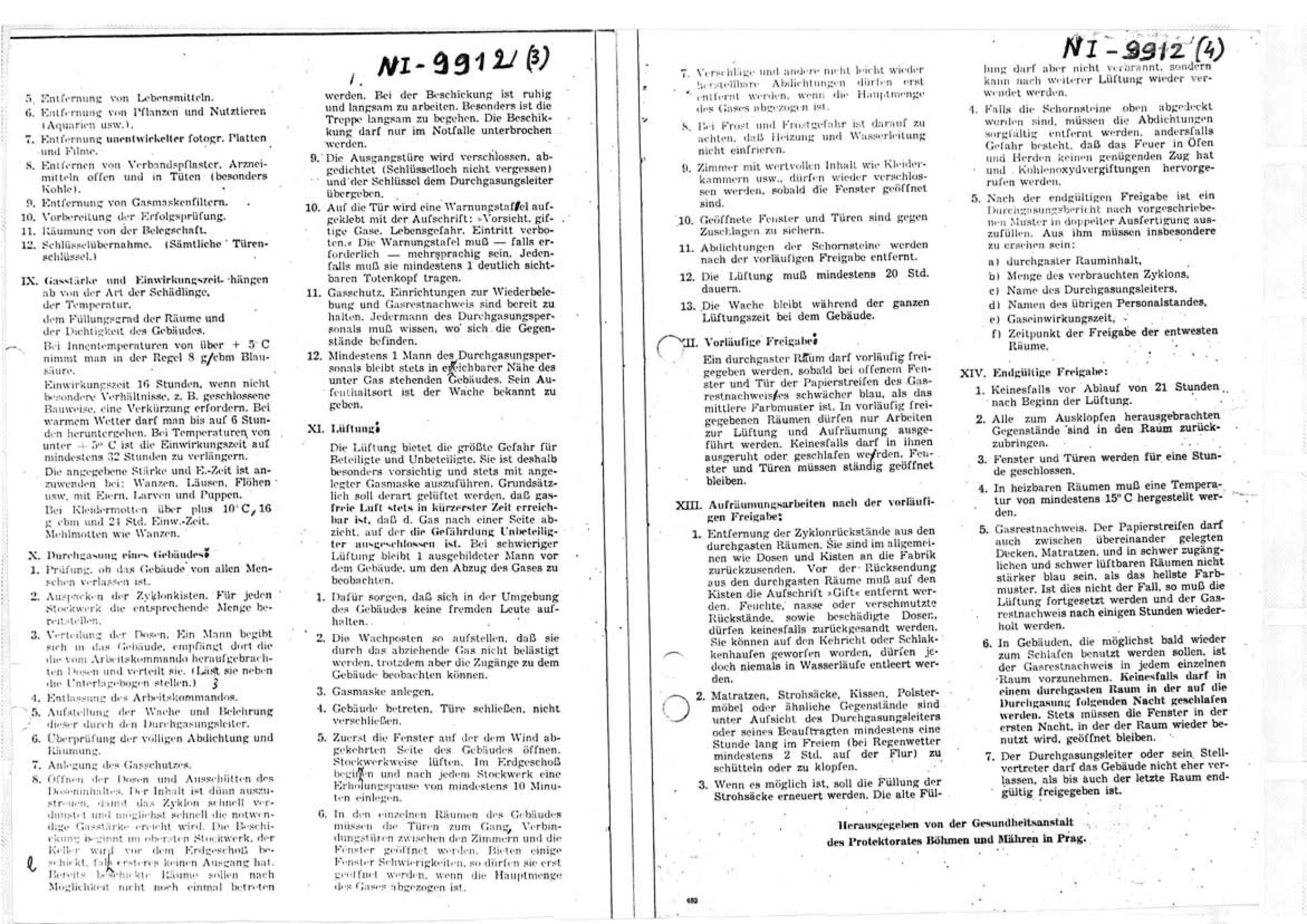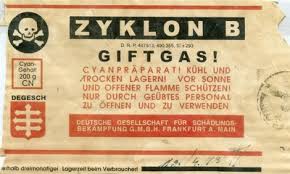A document, among others, stating the explosive nature of Zyklon
The American revisionist Fritz Berg maintains that there is no document stating that Zyklon is explosive. He is wrong, as proved by the document NI-9912 (“NI” stands for “Nuremberg Industrialists”).
This document from the Nuremberg trials archives bears the title Richtlinien für die Anwendung von Blausäure (Zyklon) zur Ungeziefervertilgung (Entwesung), i.e. “Guidelines for the use of prussic acid (Zyklon) for exterminating vermin (disinfestation)”. It was registered by the Allies on August 21, 1947. It has no date because it is a kind of prospectus of four very big pages divided in fourteen sections, all of it in eight columns. This prospectus of the Degesch firm (Deutsche Gesellschaft für Schädlingsbekämpfung or “German company for the fight against vermin”) appears to have been posted on walls at places where operations of disinfection or disinfestation with Zyklon were carried out. In the very first column one section is entitled “Explosionsgefahr”, i.e. “Danger of explosion”; as is normally done in such cases, it indicates the parameters within which this danger exists in principle and those within which, also in principle, it does not exist. The manufacturers hide nothing of the dangers and complications of their product’s use.
Personally, I had found a mention of this document while reading the first edition of Raul Hilberg’s big book The Destruction of the European Jews (1961; 1967 printing, Quadrangle Books, Chicago, p. 567, note 55, reproduced in 1985 in note 70 on p. 886 of the “Revised and Definitive Edition” – Holmes & Meier, New York and London – of the same work). Whilst Hilberg provided no extracts or details of NI-9912 but only its title, I was able to find the document itself at the Contemporary Jewish Documentation Centre (CDJC) in Paris, which I steadily frequented from the early 1960s until the beginning of 1977, when I was expelled under the threat, proffered by “master” Meram, of being forcibly ejected should I ever return there. This document will be found attached, first in its original German version with some slight annotations written in my hand, then in an English version that is an improvement on the official translation made by Dorothea Galewski. Since the late 1970s I have exploited the contents of document NI-9912 (as well as document NI-9098) a good deal in my publications and conference talks, notably at a gathering organised in New York by F. Berg himself; shortly before he had welcomed me at his home, with his mother by his side. I have also published a French translation of NI-9912.
Combining the rich data of that piece with the material offered by my discovery at the Auschwitz State Museum on March 19, 1976 of the Auschwitz and Birkenau crematoria building plans (kept hidden there since the end of the war), I have been able to demonstrate the inanity of the “confession of Rudolf Höss”, one of the three successive commandants of the Auschwitz-Birkenau camp; according to him, when the screaming of the victims in the “gas chamber” had stopped, a ventilation apparatus was “immediately” (sofort) turned on and the members of the Sonderkommando, entering, disentangled and regularly removed up to 2,000 bodies. So we are told. “Bei Leichenschleppen assen sie oder rauchten”: while dragging out the bodies they ate or smoked. In other words, they wore no gas masks and did not care whether they caused an explosion. The stuff of novels! Given the dimensions of what, in reality, according to the plans that I had discovered, were mere Leichenkellern (depositories for corpses), gas would hardly have been necessary for the killing, since the 2,000 persons packed into a space of 210 square metres would have asphyxiated in a short time. In my book Mémoire en défense contre ceux qui m’accusent de falsifier l’histoire (Memorandum in defence against those who accuse me of falsifying history, La Vieille Taupe, Paris 1980, XXIV-280 p.), appendix 13 (p. 165-178) was presented in the following terms: “The NI-9912 document: it annihilates all the alleged ‘testimonies’, without exception, on the use of Zyklon B to kill human beings”.
To install in a crematorium a “gas chamber” operated with a gas known for its risk of explosion (Explosionsgefahr) would have been the height of folly and madness. See crematorium no. I, that of Auschwitz-I: there was not the least separation between the room containing the ovens and the space described for us as having been a gas chamber (actually a corpse depository later transformed into a bomb shelter). Moreover, at the end, the gas removed by ventilation would quickly have reached the SS hospital standing just beside. See also crematoria nos. II and III, those of Auschwitz-II or Birkenau: here as well, at the end, during and after the removal of the bodies, nothing could have prevented the poisoned air from rising via the small lift shaft to the upper floor and the oven room. And finally, if the spaces were intended to serve either as a Leichenhalle (corpse depository or hall of crematorium no. I) or as Leichenkellern (corpse depositories or cellars of crematoria nos. II and III), can anyone tell me where the Germans would have been able to keep the bodies of civilians or soldiers that had to be cremated each day? What sort of thing would a crematorium with no room for keeping bodies awaiting cremation be?
I am chagrined at not being able to say more today. Time is short for me. At 86, a heart patient improvising as home nurse for his wife of 83, all the while in the calamitous position of facing six court cases at once, has but little time ahead of him. If, quite against my will, I have been led to write this note it is because I wish that F. Berg would cease his denial of simple facts and so put an end to his attacks against Fred Leuchter, Fredrick Töben and, to a lesser extent, Germar Rudolf. And then, perhaps his attacks against my person as well!
PS: F. Berg asserts that, if the Germans had wanted to murder Jews en masse, they had a weapon: the extensive hangars for disinfection of railway locomotives or carriages. He was mistaken. He should have remembered that killing a human being with Zyklon or HCN in practically any place does not in itself present too great a difficulty while, on the other hand, entering an enclosure to fetch and remove a single cyanide-infused corpse – or, as in the conventional narrative of “the Holocaust”, hundreds or thousands cyanide-infused corpses – is, or would be, another matter entirely. I have dealt so much with this subject and the extraordinary but indispensable complication of the execution gas chambers formerly used in the United States that I shall not go over it again here: a very brief summary of my position can be read in my piece, in the form of a letter, from September 2009: On the possibility of mass gassings.
July 9, 2015
Below, reproductions of three documents :
1 – The Degesch prospectus in its original form
2 – The same prospectus in English translation
3 – A page from Life magazine of December 22, 1947 relating a disastrous use of HCN for the fumigation of a house











